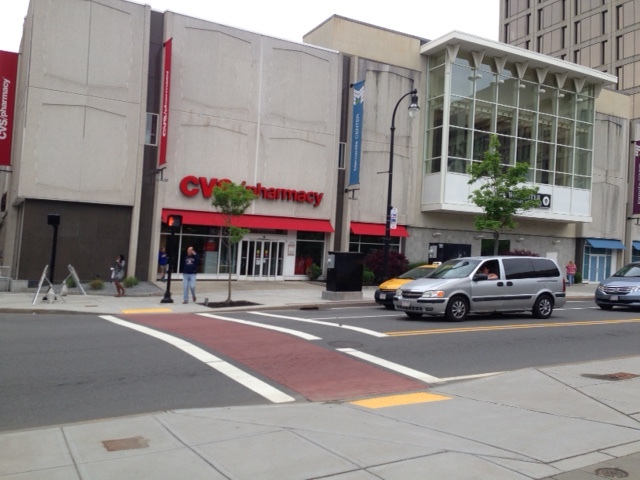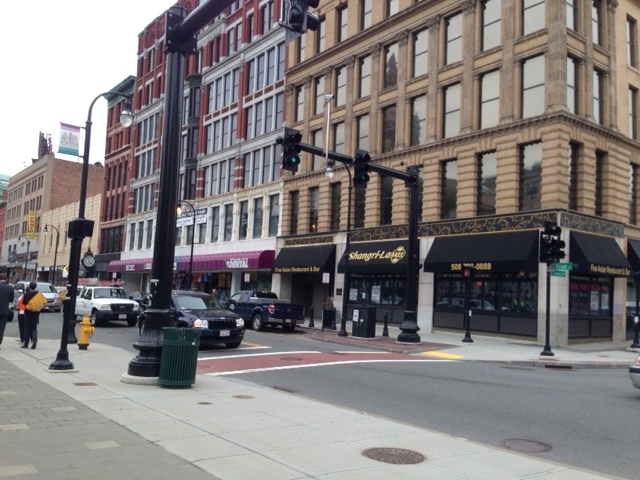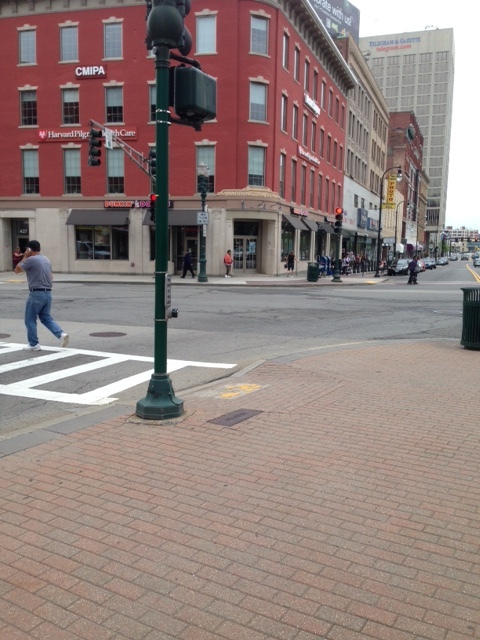Who exactly is Dan Burden and why is he going for a walk with us here in downtown Worcester? Dan is not an engineer. Dan is not even a professionally trained urban planner, architect or designer. So, who is Dan Burden and why are cities all across the country asking him to give advice on how to design walkable, livable urban streets? As a former professional photographer for National Geographic Magazine, Dan developed a keen eye that has been able to observe what makes a city thrive. He has traveled to cities around the world and even made a solo bike trek from Alaska to Argentina. As the founder of Walkable Communities, a non-profit dedicated to promoting urban walkability, he rarely slows down now, visiting cities across the country to design streets for people and not just for cars.
Dan was here in Worcester as the keynote speaker for the Massachusetts Smart Growth Alliance conference on June 2nd. Several hundred community developers, planners and activists across the state, interested in everything from housing, environmental justice, economic development descended on our city to explore ideas of how to prevent suburban sprawl and create densely compact, walkable and lively Massachusetts cities. Dan stayed the next day to do a walking audit with us locals and other conference goers.
Here are three interesting tidbits gleaned from this conference:
1) Baby boomers may have yearned for the suburbs and the freedom of roads and cars but millennials are different. Freedom is not owning a car and living in a city where one can get to work, home, the grocery store, bar and restaurant on foot, bike or public transportation. The good place to live for millennials has plenty of nightlife, street life, culture and activity. For this generation, it is a status symbol not to own a car.
2) Studies have shown that longevity and health is closely tied to the nature of the built environment. Those who are the healthiest tend to live in communities where every place they need to be (home, work, shop, worship) is within a one mile radius. Think about your own life. Can you go within a mile to find everything you need or do you have to get in a car to commute?
3) This shift in interest to walkable, dense urban spaces has resulted in a high demand for real city living and consequently higher prices for housing in once- abandoned urban cores. In quickly gentrifiying neighborhoods, bodegas are being replaced by yoga studios, mom and pop corner stores by fancy juice bars. Boston is struggling with this now. Worcester is not as of now but how can we assure that Worcester and other cities maintain affordability for the residents who are already here?
For this walking audit, our group asked ourselves, "how can we make Worcester more friendly to walkers and bikers?" Let's design a Worcester for people, not cars. Dan brought his measuring tape with him and we set out from Union Station towards city hall.
Our first stop was on the sidewalk next to the street for buses to turn into the station. We saw a bus careening in to the turn! See! Dan took out his measuring tape. This road is 32 feet, way too wide and made for speed. A good, safe road will have car lanes measuring around 10 feet.
At least we can walk from Union Station to downtown now. That is a major improvement. There is no longer a parking garage and mall in the way, but Major Taylor Boulevard functions like a highway. We could get the traffic through even if this road was cut down to two lanes. Wider roads make it harder for pedestrians to find the time to cross. At this crucial intersection at the corner of Front and Foster Streets, Dan suggested we might consider a roundabout, the same kind of streetscape in front of Union Station.
" Hey", Dan asked, "Where are the signs telling us where to go and how long it will take to get there?" Pedestrian friendly cities have signage to help the walker find his or her way. One member of our group mentioned that Worcester will be developing better signage this year through a comprehensive wayfinding program.
These kind of buttons for pedestrian crossings are the way of the dinosaurs. Get with the times, Worcester. Dan suggests we ditch these buttons in the areas we want to be pedestrian rich zones. Our lights can be on automatic sixty second cycles to give the pedestrians and cars shared turns for movement.
This part of the street works well - just one lane in either direction, small and human scaled, large sidewalks, but what is going on with this huge light fixture? It's heavy looking and probably very expensive and check out the security cameras on top. The streetscape here may call for ditching the light altogether and putting a "stop" sign on the corner of Commercial and Front Streets.
Look at the two pictures below. The buildings in one work well to provide "eyes on the street" and the buildings in the other photo don't. Can you guess which one and why?
The buildings on the left DON'T function well. See that there are no windows on the upper floors that are welcoming to the people who are walking there. Compare that to the older building stock in the photo on the right. Look at all the windows on all the floors creating a friendly, transparent street where people feel more secure.
Now a word about parking and parking garages: Worcester has retrofitted most of our downtown for cars. Dan asked how much a monthly parking space cost downtown. The answer is $80 - $120 a month for a parking space during work hours. In truly vibrant downtowns, monthly parking spaces can go up to $600. Don't give away parking!! What cities need to do is capture the motorists on the outer edges of the downtown. People park on the outer edges encouraging walking and the use of alternative transportation (buses, bikes). Think about it! We should stop creating parking lots with every new development or taking out our existing infrastructure for parking especially in areas we want to be walkable and vibrant.
This plaza in front of city hall works well here. In fact, Dan gave this whole area an A. We have retail down here, the functions of city hall, this pedestrian plaza, the historic buildings. This is the heart... right here. Now, we just have to increase the housing so people are living here and the area does not go to sleep after the workday. The walkscore is probably high here where we are standing. His suggestion for improvement: The intersection at Main Street and Pleasant Street might be a good candidate for removing the lights altogether to provide shared space use of cars, bikers and walkers. Look up seven dials in England, he suggested.
City Manager Ed Augustus met us outside of city hall to hear Dan's assessment of the downtown.
These buildings at the corner of Main and Pleasant Streets work well for the street. Notice the rounded corners and lettering of the Harrington Corner. The wall of windows and the diagonal line triangulating the sidewalk of the modern building diagonally across the street make an interesting walk-pass.
Look at how three lanes of one way traffic on Chestnut Street cross straight onto Pleasant. This is a street in dire need of a road diet! We could definitely cut this down to one lane of traffic and then Dan suggested we think of diagonal parking on either side.
You can see these walkers on Main Street across from the Hanover Theater crossing Chatham Street. They waited awhile to get that light after hitting the walking button. In the area that has frequent pedestrian activity such as this, you can have automatic walk intervals to allow pedestrians to cross and make pedestrian activity more predictable. In fact, if the light on Main Street is green, walkers could have an automatic signal to cross. Technical terms for this kind of signaling is called, "concurrent pedestrian phase." Changing these signals could make a huge impact on the walkability of the city.
Here is one more idea about making walking more pleasant on our city streets. Let's just stop the current "Barnes Dance" pedestrian scrambles. If you are a walker, you know this kind of signaling. You press the light, wait and wait until the signal is given and all directions of intersection traffic stop for the pedestrians. The problem: Both walkers and drivers are frustrated with the wait they are forced to endure because of this signaling. You know the drill. Press the button. Wait and wait and wait. Get impatient. Try to cross anyway. Cross. Light changes. All cars are stopped but you have already crossed so the traffic in all four directions stop for no reason. Frustration!
This alley behind the Hanover theater is just begging to be made into something incredible! This could be a fantastic pedestrian walk through. Imagine clearing the space of dumpsters, paving the area with interesting cobblestones and making the space a point of interest. We could have seating there, maybe a restaurant.
This tunnel feels unsafe, noisy and dirty but tunnels can be potential places of interest with widened sidewalks and art painted on the walls.















